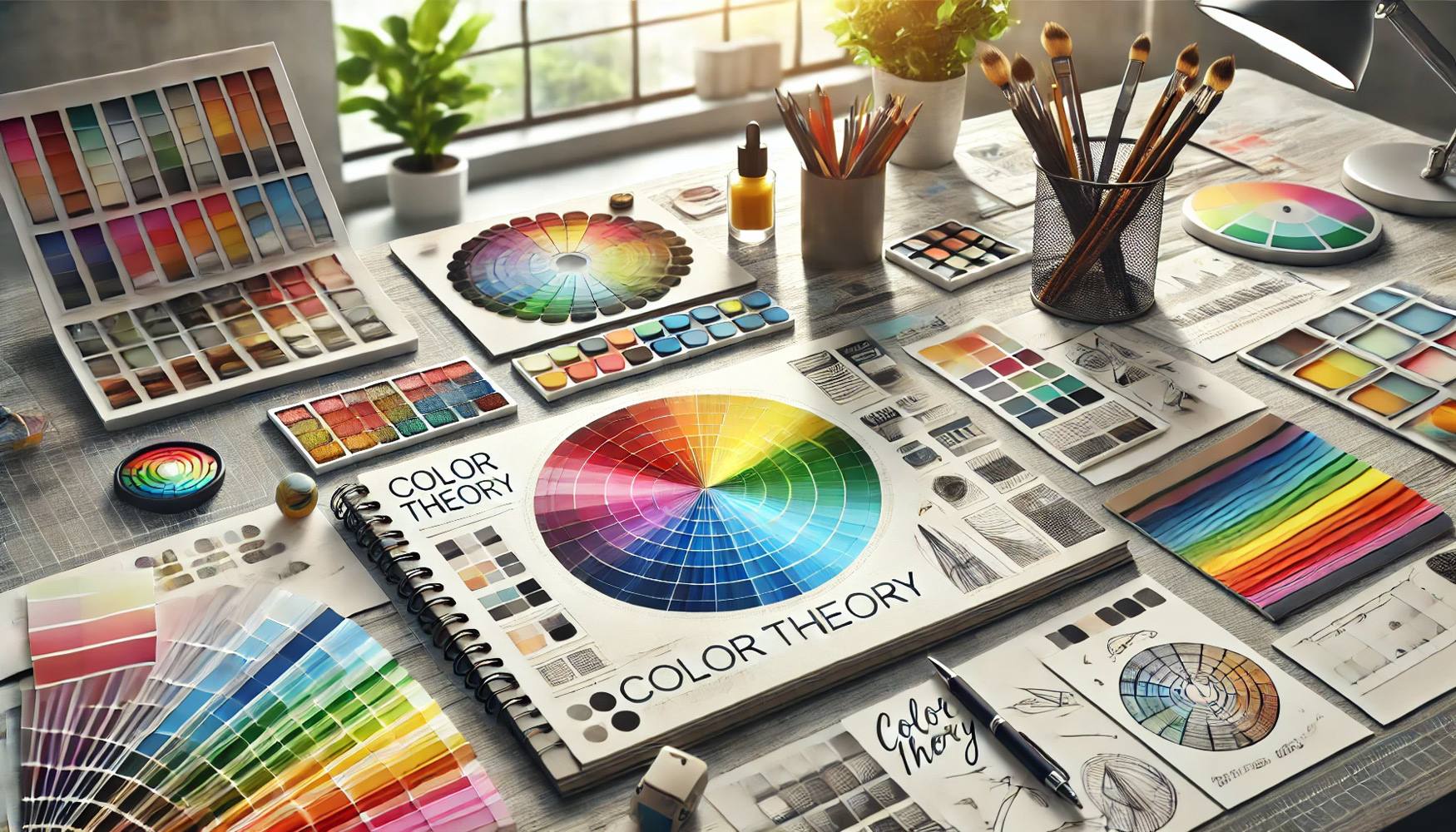
Seven very important rules for color coordination for you as a professional graphic designer
- omranshain
- 2 Comments

Seven Essential Color Harmony Rules for You as a Professional Graphic Designer
In the world of graphic design, understanding color and achieving harmony between them is fundamental to creating visually appealing designs that effectively convey the intended message.
Below, we present seven of the most important color coordination rules and schemes using the color wheel, supported by practical examples and applications.

Monochromatic Color Rule
This rule is based on using a single color in its various shades, from light to dark. It’s an ideal approach for achieving a clean and calm design. Example: Using different shades of blue—from navy to sky blue—in the design of a medical website or an official page. The Advantage: It enhances a sense of consistency and visual harmony.

Complementary Color Rule
This rule relies on selecting two colors that are directly opposite each other on the color wheel. This approach emphasizes contrast and captures attention. Example: Orange and blue, or red and green, used in the design of an advertisement or a logo. The Advantage: Perfect for headlines or buttons you want to highlight.

Triadic Color Rule
This rule uses three colors that are evenly spaced on the color wheel, forming an equilateral triangle. It provides a dynamic yet balanced color scheme. Example: Red, yellow, and blue in a promotional poster or a children’s design. The Advantage: Vibrant colors that maintain harmony without clashing.

Analogous Color Rule
This rule involves using three colors that are adjacent to each other on the color wheel. It evokes a sense of natural harmony. Example: Green, yellow-green, and blue-green in interior design or a nature-themed poster. The Advantage: Easy to blend and provides visual calmness.

Analogous Colors with a Complement Accent
This rule combines three adjacent colors with one complementary (opposite) color, adding a bold and distinctive touch. Example: Violet, blue-violet, and blue with a splash of yellow. The Advantage: A balanced mix of harmony and contrast.

Split-Complementary Color Rule
This rule involves selecting a base color along with the two colors adjacent to its complement. It offers a soft contrast without being too intense. Example: Orange with blue-green and blue-violet. The Advantage: Suitable for balanced and modern designs.

Tetradic Color Rule
This rule uses four colors consisting of two complementary pairs, forming a rectangle on the color wheel. Example: Blue and orange combined with red and green. The Advantage: Rich in color and ideal for bold, complex designs.
Additional Tips for Designers
-
Use neutral colors (gray, white, black) to balance contrast.
-
Avoid using more than 3–4 main colors in a single design to prevent visual clutter.
-
Try applying these rules using design tools like Adobe Color or Coolors.
By following these principles, you’ll be able to create visually harmonious designs that clearly communicate ideas and appeal to your target audience.
Make the color wheel your closest ally in every design project.
سبعة قوانين مهمة جدًا لتناسق الألوان.. لك كمصمم جرافيك محترف
في عالم التصميم الجرافيكي، يعتبر فهم الألوان وتناسقها أمرًا أساسيًا لإنتاج تصاميم جذابة بصريًا وتوصل الرسالة المطلوبة بفعالية. فيما يلي نُقدم لك سبعة من أهم القواعد أو الخطط لتنسيق الألوان باستخدام عجلة الألوان، مدعومة بالأمثلة والتطبيقات العملية

قاعدة اللون الأحادي
تعتمد هذه القاعدة على استخدام لون واحد بدرجاته المختلفة، من الأفتح إلى الأغمق. تعتبر هذه الطريقة مثالية للحصول على تصميم بسيط وهادئ. مثل : استخدام درجات الأزرق من الكحلي حتى السماوي في تصميم موقع إلكتروني طبي أو صفحة رسمية. والميزة: تعزز الشعور بالاتساق والتناغم البصري

قاعدة الألوان المتقابلة
تعتمد على اختيار لونين متقابلين تمامًا في عجلة الألوان. هذه الطريقة تُبرز التباين وتجذب الانتباه. مثل : برتقالي وأزرق، أحمر وأخضر في تصميم إعلان أو شعار . والميزة: مثالية للعناوين أو الأزرار التي تريد إبرازها

قاعدة الألوان الثلاثية
تُستخدم فيها ثلاثة ألوان تكون موزعة بشكل مثلث متساوي الأضلاع على عجلة الألوان، وتوفر توازنًا لونيًا ديناميكيًا. مثل : الأحمر، الأصفر، والأزرق في ملصق دعائي أو تصميم للأطفال. والميزة: ألوان نابضة بالحياة دون أن تكون متنافرة

قاعدة الألوان المتجاورة
تتضمن استخدام ثلاثة ألوان متجاورة على عجلة الألوان. توحي هذه القاعدة بالانسجام الطبيعي. مثل: أخضر، أصفر-أخضر، وأزرق-أخضر في تصميم داخلي أو بوستر طبيعي. والميزة: سهلة الدمج وتمنح هدوء بصري

قاعدة الألوان المتجاورة مع لون مميز
نستخدم ثلاثة ألوان متجاورة بالإضافة إلى لون متقابل معها، مما يُضفي لمسة جريئة ومميزة. مثل: بنفسجي، أزرق بنفسجي، أزرق، مع أصفر. والميزة: توازن بين الانسجام والتباين

قاعدة الألوان المكملة المنقسمة
نختار لونًا أساسيًا ثم اللونين المجاورين للونه المكمل. تمنح هذه الطريقة تباينًا خفيفًا بدون حدة. مثل: برتقالي مع أزرق-أخضر وأزرق-بنفسجي. والميزة: مناسبة لتصاميم متوازنة وعصرية

قاعدة الالوان الرباعية
تعتمد على استخدام أربعة ألوان مكونة من زوجين من الألوان المكملة، وتُشكل مستطيلًا على عجلة الألوان. مثل: أزرق وبرتقالي مع أحمر وأخضر. والميزة: غنية لونيًا وتناسب التصاميم الجريئة والمعقدة
نصائح إضافية للمصممين
-
استخدم الألوان المحايدة (رمادي، أبيض، أسود) لموازنة التباين
-
لا تستخدم أكثر من 3-4 ألوان رئيسية في التصميم الواحد لتجنب الفوضى البصرية
-
Adobe Color أو Coolors جرّب القواعد على أدوات تصميم مثل
باتباع هذه القواعد، ستكون قادرًا على إنشاء تصاميم متناسقة بصريًا، تُعبر عن الأفكار بوضوح وتُرضي ذوق الجمهور المستهدف. اجعل عجلة الألوان صديقك الأقرب في كل مشروع تصميمي

omran Shain
passionate about bringing your creative vision to life. Let’s craft something extraordinary together!
Categories
Recent News


Fawasel Media Platform Social Media Graphic Identity

News Templates Strategy
" Design is more than a skill, it is a way of thinking that empowers us to create amazing solutions, to learn and grow constantly, and to deliver excellence and innovation. "

- Faq
- Privacy Policy
- Terms & Condition
Copyright © Omran Shain . All rights reserved

نوارة باش مهندس عمران
ربي يعطيك الصحة يا غالي وطولة العمر
دائما نستفيد منك
اهلا وسهلا بيك سيد عوض .. يسعدني مرورك ومتابعتك يا عزيزي